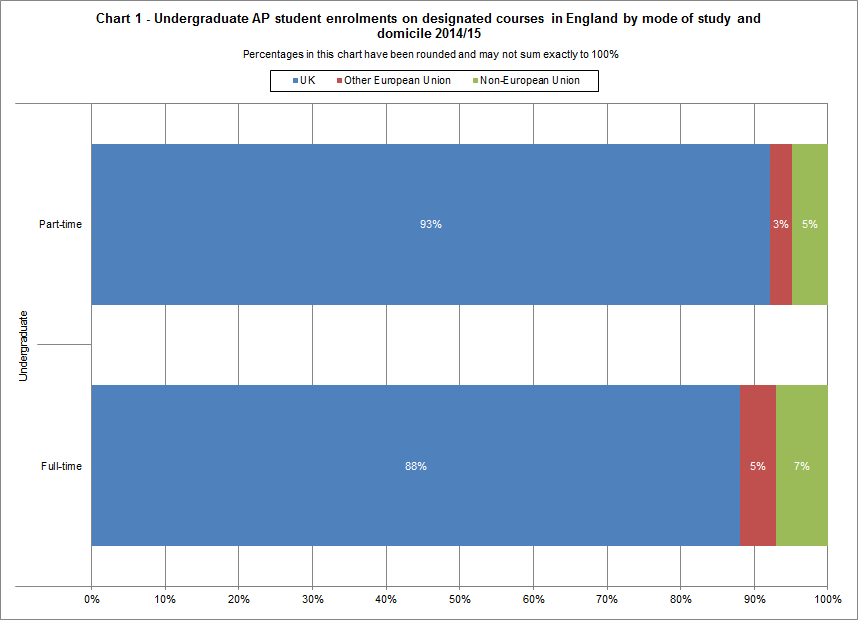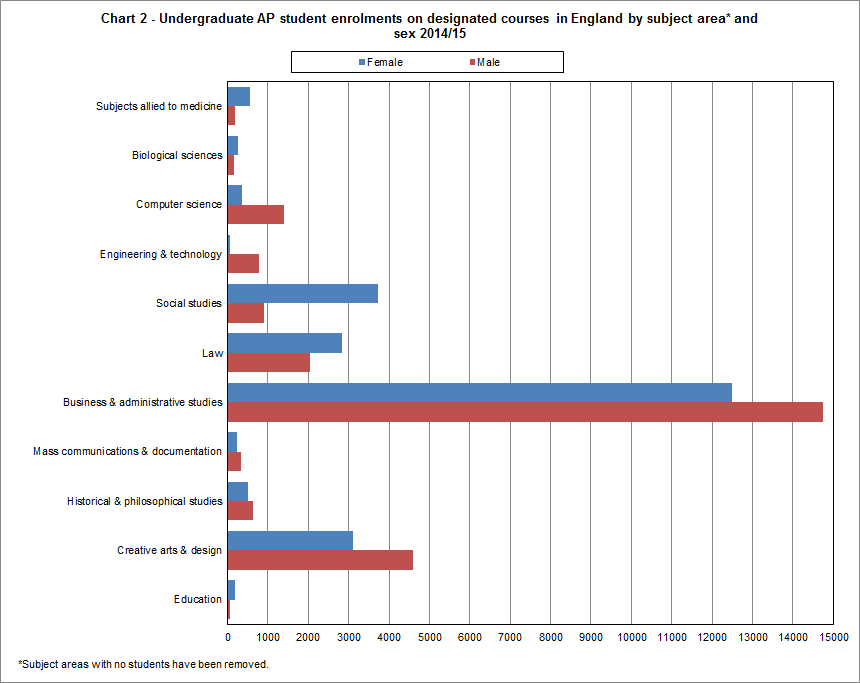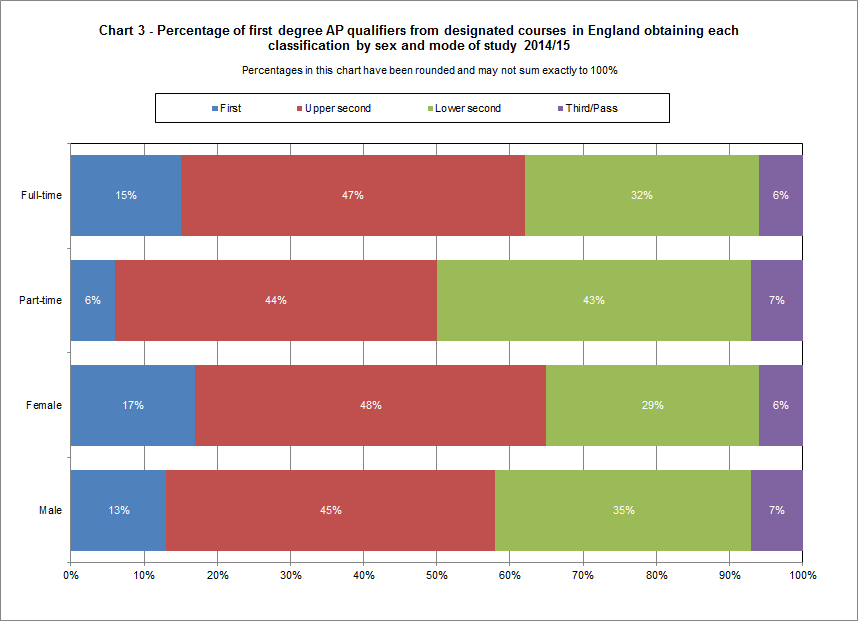Higher education student enrolments and qualifications obtained on undergraduate designated courses at alternative providers in England 2014/15
Introduction
Alternative providers (APs) are higher education (HE) providers who do not receive recurrent funding from the Higher Education Funding Council for England (HEFCE) or other public bodies and who are not further education (FE) colleges. Eligible students can access loans and grants from the Student Loans Company (SLC) on specific courses, referred to as designated courses.
The AP SFR provides details of undergraduate student enrolments and qualifications obtained on designated courses by HE students at APs in England for the academic year 2014/15 who returned data to HESA. The APs who returned data to HESA in 2014/15 were large providers who offered HE courses within the AP sector. The AP SFR includes all undergraduate HE students enrolled on designated courses at these APs irrespective of whether the student was in receipt of SLC funding.
This Experimental Statistical First Release (SFR) has been produced by the Higher Education Statistics Agency (HESA) in collaboration with statisticians from the UK Department for Business, Innovation and Skills (BIS) and with support from analysts from HEFCE.
HESA have collected data from 63 APs in 2014/15 which fall within the coverage of the HESA AP Student record. Provision of HE by APs in England is much wider than this; in the BIS report Understanding the Market of Alternative Higher Education Providers and their Students in 2014 it states that there were 732 APs as of spring 2014. Therefore, the AP SFR reports on partial coverage of the AP sector and the courses which are offered within it. Thus, the AP SFR does not report total student numbers enrolled at APs in England.
With this in mind, the release of the AP SFR means that we are moving towards being able to report a more complete picture of undergraduate HE provision in England. The table below shows the number of undergraduate enrolments at publicly funded providers (including The University of Buckingham), further education colleges and APs.
| Undergraduate student enrolments in England | 2014/15 |
|---|---|
| Publicly funded providers (including The University of Buckingham) | 1401515 |
| Alternative providers (designated courses) | 50245 |
| FE colleges | 124935 |
The AP SFR is published as "Experimental Statistics" as we are continuing to explore and understand the quality of the data that has been returned in the first full HESA collection of student data from these providers. We realise that there is great interest in HE that is delivered outside publicly funded providers and further education colleges. HESA welcome feedback on the content, structure and usefulness of the statistics presented in the AP SFR, please email any comments or suggestions to Emma Jones.
Key points- undergraduate enrolments
- There were 50,245 undergraduate HE enrolments on designated courses at APs in the 2014/15 record.
- 47,665 of these enrolments were on full-time designated courses compared to 2,580 on part-time designated courses. This likely reflects that there are fewer part-time designated courses than full-time designated courses, rather than the true balance between full-time and part-time provision in the AP sector.
- 48% of students were enrolled on first degree designated courses, 45% of students were enrolled on HND/HNC designated courses, 6% of students were enrolled on other undergraduate designated courses and 1% of students on foundation degree designated courses.
- The majority of these undergraduate HE enrolments (88%) were UK domiciled.
- The majority of EU and non-EU domiciled students (75% and 84% respectively) at APs were enrolled on first degree courses whereas the majority of UK domiciled students (50%) were enrolled on HND/HNC designated courses.
[Reference Table 1 and Chart 1]

Key points- first year undergraduate enrolments
- There were 22,000 first year HE enrolments on designated courses at APs in the 2014/15 record.
- 20,480 of these enrolments were on full-time designated courses compared to 1,520 part-time designated courses. Again, this likely reflects that there are fewer part-time designated courses than full-time designated courses, rather than the true balance between full-time and part-time provision in the AP sector.
- 46% of first year students were enrolled on first degree designated courses, 43% of students were enrolled on HND/HNC designated courses, 10% of students were enrolled on other undergraduate designated courses and 1% of students on foundation degree designated courses.
- The majority of first year students (88%) at APs were UK domiciled.
[Reference Table 2]
Key points- subject of study and demographics of undergraduate enrolments
- The majority of students (54%) were enrolled on Business and administrative studies designated courses, this was also true of full-time and part-time courses.
- 8% of students on designated courses were enrolled within Science subject areas. This reflects that the majority of the designated course provision at APs tends to be in Business and administrative studies and Creative arts and design.
- Computer science (79%) and Engineering and technology (91%) were subjects with a majority of male students, whereas Social studies (80%) and Subjects allied to medicine (74%) were subjects with a majority of female students.
- The majority of first year students (52%) were enrolled on Business and administrative studies designated courses.
[Reference Table 4, Table 5 and Chart 2]

- Table 6 and 7 include data on sex, age, disability and ethnicity of full-time and part-time undergraduate enrolments on designated courses.
- The gender split for full-time enrolments was 48% female and 52% male which was exactly the same as for the gender split for part-time enrolments.
- In comparison to statistics for student enrolments in 2014/15 at publicly funded HE providers published in Statistical First Release 224 - Student Enrolments and Qualifications, the proportion of females enrolled at APs was slightly lower. 55% of full-time undergraduate and 61% of part-time undergraduate females enrolled at publicly funded HE providers in 2014/15.
- 43% of full-time enrolments were aged 30 and over, compared to 38% of part-time enrolments at APs. 23% of full-time enrolments were aged 20 and under compared to 6% of part-time enrolments at APs.
- In comparison to statistics for student enrolments in 2014/15 at publicly funded HE providers published in Statistical First Release 224 - Student Enrolments and Qualifications, the age profile of students at APs differed. The majority of full-time students enrolled at publicly funded HE providers (63%) were aged 20 and under and only 6% of full-time students were aged 30 and over. This was the opposite for part-time students, with the majority (57%) aged 30 and over and only 9% aged 20 and under.
- The age profile of students also differed by subject area of study at APs. 70% of full-time students studying Subjects allied to medicine and 67% of full-time students studying Social studies were aged 30 and over. 59% of full-time students studying Creative arts and design and 55% of full-time students studying Biological sciences were 20 and under. Chart 6 shows the age profile of students by subject area of study for part-time students.
- The disability status was similar amongst full-time and part-time enrolments with 7% full-time and 5% of part-time known to have a disability.
- In comparison to statistics for student enrolments in 2014/15 at publicly funded HE providers published in Statistical First Release 224 - Student Enrolments and Qualifications, the percentage of those with a known disability at APs was slightly lower. 12% of both full-time and part-time undergraduate students at publicly-funded HE providers were known to have a disability.
- Of the UK domiciled undergraduate students with known ethnicity, the ethnicity profile of the 33,625 full-time students was more varied than the 1,900 part-time students. 39% of full-time students were White, 34% were Black, 19% were Asian and 7% were Other (including mixed ethnicity). In comparison, 73% of part-time students were White, 10% were Black, 10% were Asian and 7% were Other (including mixed ethnicity).
- In comparison to statistics for student enrolments in 2014/15 at publicly funded HE providers published in Statistical First Release 224 - Student Enrolments and Qualifications, the ethnicity profile of UK domiciled undergraduate students with known ethnicity differed to AP undergraduate students. There were higher proportions of White undergraduate students enrolled at HE providers in the HESA Student record, with 77% full-time and 84% part-time enrolments.
[Reference Table 6 and Table 7]
Key points- undergraduate qualifications obtained
- In 2014/15, there were 10,645 undergraduate qualifications awarded from designated courses. Of these, 39% were first degree, 40% were HND/HNC, 20% were other undergraduate and 1% were foundation degree. [Reference Table 8]
- Of those gaining a classified first degree, the proportion who obtained a first or upper second was 61%. 15% gained a first class degree compared to 46% who gained an upper second class degree.
- Of those first degree qualifications achieved by females in 2014/15, 65% were at first or upper second level in comparison to 58% of first degree qualifications achieved by males. [Reference Table 9 and Chart 3]
- 7% of qualifications obtained were in Science subjects. Again, this may reflect subject areas of designated course provision at APs. 52% of qualifications obtained were in the subject area Business and administrative studies. [Reference Table 10]

Tables
| Undergraduate AP student enrolments on designated courses in England by mode of study, sex, level of study and domicile 2014/15 | |
| First year undergraduate AP student enrolments on designated courses in England by mode of study, sex, level of study and domicile 2014/15 | |
| Undergraduate AP student enrolments on designated courses in England by HE provider, mode of study and domicile 2014/15 | |
| Undergraduate AP student enrolments on designated courses in England by subject area, mode of study and sex 2014/15 | |
| Undergraduate first year AP student enrolments on designated courses in England by subject area, mode of study and sex 2014/15 | |
| Undergraduate full-time AP student enrolments on designated courses in England by subject area, sex, age group, disability status and ethnicity 2014/15 | |
| Undergraduate part-time AP student enrolments on designated courses in England by subject area, sex, age group, disability status and ethnicity 2014/15 | |
| Undergraduate AP qualifications from designated courses in England obtained by sex, mode of study and domicile 2014/15 | |
| First degree AP qualifiers from designated courses in England by sex, mode of study and class of first degree 2014/15 | |
| Undergraduate AP qualifications obtained from designated courses in England by sex and subject area 2014/15 |
None of the tables presented should be interpreted without reference to the Notes and Definitions provided below.
Notes
What is the coverage of the HESA AP record 2014/15?
The larger APs who offered HE courses in the sector, and were subject to student number controls, were required to report on students who followed full-time and part-time undergraduate and postgraduate ITT courses that were designated for student support purposes. This was irrespective of whether the student was in receipt of SLC funding.
Those students who studied wholly outside of the UK for the duration of their programme, who were expected to spend less than eight consecutive course weeks in the UK during their entire programme or were studying on postgraduate courses that were designated for Disabled Students Allowance (DSA) only are not included in the record.
The reporting of the elements of the AP student record 2014/15 for UNISTATS was optional for providers, and any data submitted solely for this purpose is excluded in the AP SFR.
Though APs offer more flexible provision in terms of commencement dates of courses, the AP student record was collected on the basis of the HESA reporting period. This ensures consistency across the data collected. The 2014/15 AP student record was collected in respect of activity which took place between 1 August 2014 and 31 July 2015.
Why is this publication "Experimental Statistics"?
The Code of Practice for Official Statistics defines Experimental Statistics as: "new official statistics undergoing evaluation. They are published in order to involve users and stakeholders in their development and as a means to build in quality at an early stage".
This is the first year that the AP Student Record data has been collected and the first time that the majority of APs have submitted data to HESA. We are continuing to explore and understand the quality of the data that has been returned and the data will be continually evaluated for its stability, reliability and completion over the forthcoming annual collections. The AP SFR has been published as we realise that there is great interest in HE that is delivered outside publicly funded providers and further education colleges. HESA welcome feedback on the content, structure and usefulness of the statistics presented in the AP SFR, please email any comments or suggestions to Emma Jones.
Why should care be taken when making comparisons to the HESA Student Record 2014/15 which reports enrolments and qualifications obtained at publicly funded providers?
Readers must remember that the AP record in 2014/15 shows a partial coverage of the sector and the courses on offer. The AP SFR does not report total student enrolments and qualifications obtained at APs in England.
The 2014/15 AP record consisted of 63 APs but provision of HE by APs in England is much wider than this. In the BIS report Understanding the Market of Alternative Higher Education Providers and their Students in 2014 it states that there were 732 APs in spring 2014.
The 2014/15 AP record only reports students who are enrolled on designated courses, these courses allow eligible students to access loans and grants from the SLC. For example, low numbers of non-EU students may reflect that these students are enrolled on non-designated courses.
Please note that The University of Buckingham is an AP, but has submitted data through the HESA Student record since 2004/05 and has been reported on in the Statistical First Release 224 - Student Enrolments and Qualifications released in January 2016; consequently The University of Buckingham are omitted in the AP SFR. Care must be taken when making comparisons between the APs in the AP SFR and The University of Buckingham due to coverage differences between the records.
What will change for next year?
From 2015/16, the number of APs returning data to HESA will increase to just under 100.
APs will be required to return data about students on all undergraduate courses (with some exceptions) regardless of designation status as well as postgraduate Initial Teacher Training (ITT). The reporting of the elements of the AP student record 2015/16 for Unistats will be compulsory for all providers.
Exclusions to the AP SFR
Due to the coverage of the AP record, the only postgraduate provision that is required to be returned to HESA is postgraduate ITT. As only 20 students were reported on postgraduate ITT courses at APs in 2014/15, these students are omitted from the AP SFR.
Definitions
The data presented in the AP SFR is based on the 2014/15 HESA Alternative Provider student record. The statistics in the AP SFR are derived by HESA from data collected from the APs in England who were required to submit data to HESA for the purpose of course designation and are subject to student number controls. Please note that The University of Buckingham is an AP but return data through the HESA Student record and are omitted in the AP SFR.
AP student enrolments and qualifications data was prepared in May 2016 using the following version of the dataset: 2014/15 Original dataset, December 2015 version
Student enrolments and qualifications definitions:
- Coverage
- Course designation
- Alternative provider
- Standard registration population
- Qualifications obtained population
- Rounding strategy
- Age
- Class of first degree
- Disability status
- Domicile
- Ethnicity
- HE provider identifiers
- Level of study/Qualification obtained
- Mode of study/qualification
- Sex
- Subject of study
- Year of study/ first year marker
For data intelligence, please see the following webpage.
Press enquiries should be directed to [email protected] Tel: 01242 211120.
General enquiries about the data contained within the AP SFR should be addressed to [email protected] Tel: 01242 211133.
Ends
Embargo
15 June 2016, 9:30
Coverage
England
Themes
Children, education and skills
Issued by
HESA, 95 Promenade, Cheltenham, GL50 1HZ
Press enquiries
01242 211120
Public enquiries
01242 211133
Statistician
Emma Jones

